“It’s so awkward.”
If a harpist has said this to you, you’re not alone. Even the great composers have written impossibly awkward music for the harp. Writing idiomatically for the harp incorporates lots of variables, like navigating chromaticism with the pedals, effectively using the registers of the harp, and more. But today, we are going to focus on the important topic of voicing and interval spacings.
(This is especially relevant if you want to use the orchestration strategy of filling out harmonies with large chords or arpeggios.)
In this article, you will learn how to appropriately voice chords and arpeggios in a way that works effectively on the harp. But first, we need to go over some basics.

Harp basics

Harpists use 4 note patterns
This means that arpeggios and chords should be in groups of 4 or less. Can you ever write patterns with groups of 5 or more? Yes, if the tempo is moderate enough for cross-unders/cross-overs. However, if you are looking for a flowing arpeggio or quickly placed chord, aim for groups of 3-4.
In the example below from Strauss’s Don Juan, harpists commonly leave out the fifth note in these pattern to facilitate the necessary volume and speed.

The average pattern span on the harp is an octave
You have probably heard that most harpists can reach a 10th. This is mostly true. However, this is our maximum span, not our average span. When reaching a 10th, we have less flexibility with the inner fingers. (We will discuss strategies for utilizing 10ths later in this article). In general, consider the average span to be a 7th or 8ve. You can use occasionally use larger intervals, but aim to mostly use 8ves or less.
Larger intervals should be on top, smaller intervals on the bottom.
Unlike the piano, the hands on the harp are oriented in the same direction. This means that on both hands, the thumb plays the highest notes and the third or fourth finger plays the lower notes.
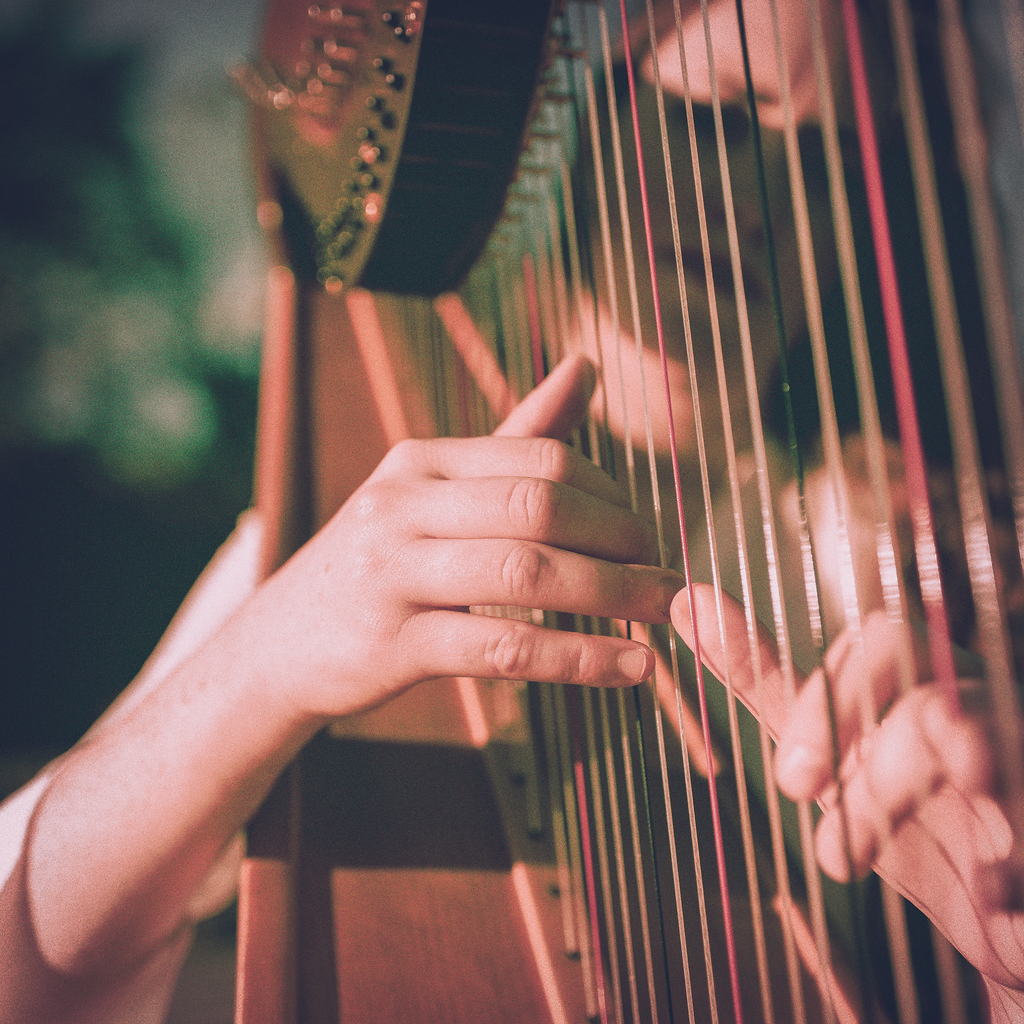
For idiomatic writing, try to minimize small intervals on the top of patterns (aim for 3rd-5th) and minimize large intervals at the bottom of patterns (aim for 2nd-3rd).
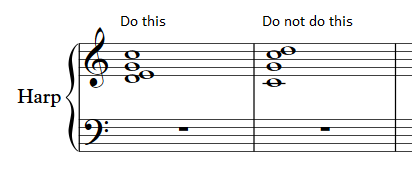
In the first example, the chord uses a larger interval between the top two notes (thumb and index finger) and a smaller interval between the bottom two notes (middle and ring finger). This pattern works well with the hand shape.
The second example uses a small interval between the top two notes (thumb and index finger) and a large interval between the bottom two notes (middle and ring finger). This pattern contorts the hand by requiring the thumb and middle finger to be close together and requiring a large stretch between the bottom two fingers. This awkwardness is exacerbated by the large overall span of the chord (9th).
To summarize the basics:
- Harpists use 4 note patterns
- The average pattern span on the harp is an octave
- Larger intervals should be on top, smaller intervals on the bottom.
- (For further study, read this post on Blocks on the Harp)
We just discussed voicing considerations related to hand shape and spans. However, to voice like a pro, you also need to consider the different registers on the harp.
Voicing According to Registers of the Harp
Since the harp has no self-dampening mechanism, we have to consider the resonance of the harp in our voicing. The strings in the lower registers of the harp can ring for 30-60 seconds, unless muffled. If too many notes are played simultaneously or in quick succession, the result can be a “muddy” or blurry sound. In addition, it is difficult to place the next pattern amongst vibrating strings without creating a nasty buzz. To work around this, use wider intervals to create a more open sound. (Learn more about the Registers of the Harp here.)
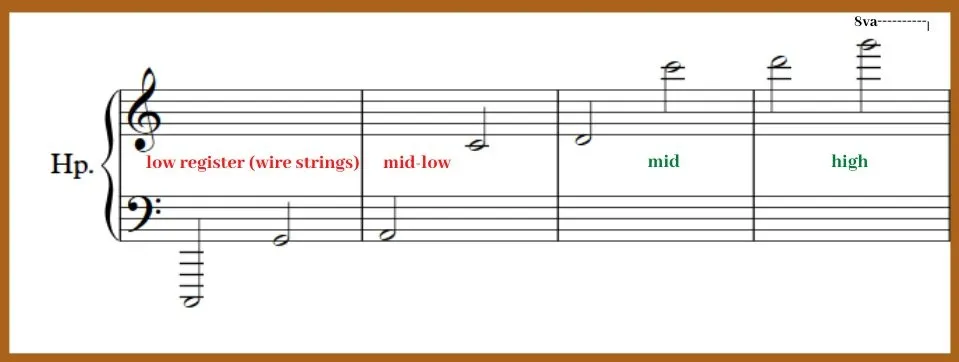
Low and Mid-Low Registers use Open Voicing
If you remember “open voicing” practice from music theory classes, this practice alternates (or skips) notes in a chord.

On the harp, you can use this technique to spread out the vibrating strings to 1. create a clearer sound, and 2. minimize the risk of buzzing.
While it is possible to use a quasi-open voicing with 4 notes (4 fingers), it creates a large span and necessitates a wide interval between the 3rd and 4th fingers (ouch!). In general, when using open voicing, aim to use 3 note patterns/chords instead of four.

Mid and High Registers use Closed Voicing
In contrast, the higher registers of the harp work quite well with traditional closed voicing with smaller intervals between notes. First, the higher strings do not ring as long and hence have less risk of buzzing or a “muddy” sound. Second, the large interval spans required for open voicing are slightly less idiomatic in the higher registers.
Playing higher on the harp means the hands are closer to the body, which reduces the mobility of the hands to reach large intervals (Try it and see! Hold your arms in front of you and see how wide you can reach your fingers. Then, hold your hands close to your body and try to reach the same span. You probably can reach the same span, but you will feel more tension in your wrists when doing so.)
Large intervals are certainly playable on the higher registers, but have more of the physical risks and less of the acoustic benefits compared to the lower registers.
To summarize voicing according to the registers of the harp:
- Use open voicing and 3 note patterns in the low and mid-low registers of the harp
- Use closed voicing and 3-4 note patterns in the mid and high registers of the harp
Note: These are not strict rules, but general guidelines!
But, are there times these should be strict rules? What about writing at different tempi?
Voicing according to speed
In addition to all of these guidelines, one final consideration is tempo.
At slower speeds, you have far more flexibility with the voicing, even if you need to strategically ignore the standard guidelines. Slower speed provide additional time for the harpist to place slightly awkward chords or patterns with ease.
However, at faster tempi, intentional voicing is crucial. The exact speed to be considered “fast” depends on the context, but you should be especially strategic when writing at 120bpm or faster. (This applies to both chords moving at 100bpm, or groupings of 16th notes arpeggios or patterns.)
Adhere to patterns
At faster tempi, try to maintain consistent patterns, both between the hands and between adjacent patterns. Due to the motions of playing required to play the harp, consistent patterns can help facilitate quick replacing.
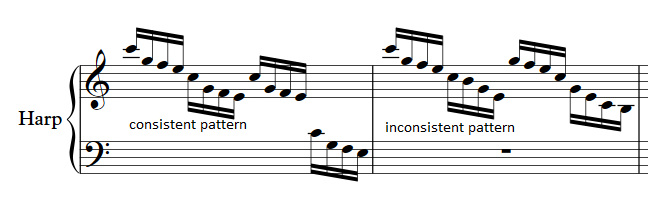
In the harp cadenza from Britten’s The Young Person’s Guide to the Orchestra (Variation I), the standard harp rewrite includes enharmonics to provide consistent patterns in the arpeggios. (Note: the circled notes indicate enharmonics as a “shortcut” notation. In standard practice, it is best to respell enharmonic pitches.) For more insights into this excerpt, watch my YouTube review here.
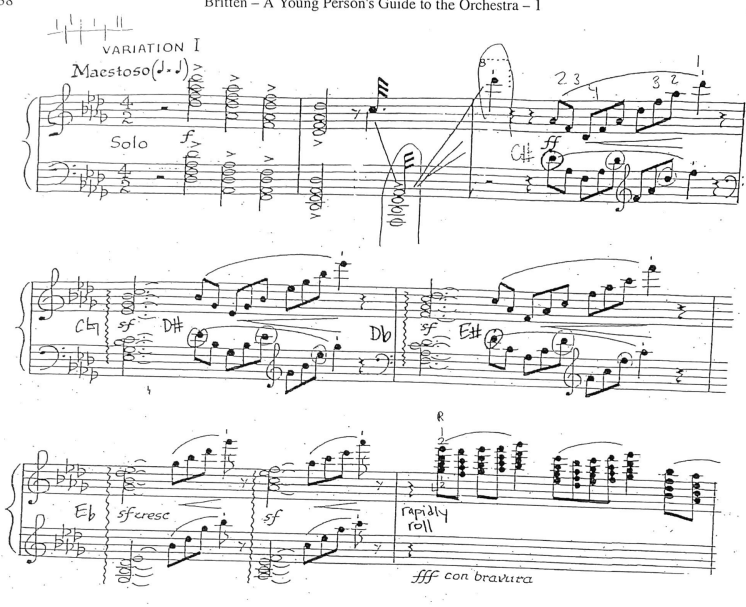
Use smaller interval spans
Larger intervals (7th+) take slightly longer to place on the harp, since it requires stretching the hand beyond the natural hand position. Yes, you can use 8ves if needed, but total spans of 6ths and 7th are even better for fast sections that require quick replacing. The rewritten harp cadenza from Tchaikovsky’s Waltz of the Flowers is a great example of how smaller interval spans can be played extremely fast! See my full YouTube review of the cadenza here.

To summarize voicing according to speed:
- Adhere to consistent patterns for chords and arpeggios
- Use smaller interval spans for quick passages
Summary
To voice chords and arpeggios on the harp, you first need to consider the basics of playing mechanics on the harp. Each hand only has 4 fingers available, hence your patterns should be in groups of 3-4 notes. The average overall span of the hand is an octave. Harpists can reach up to a 10th, but this should be used sparingly.
When writing in lower registers, opt for open voicing and use groups of 3 notes rather than 4. When writing in the upper octaves, aim for smaller overall spans and use closed voicing. When writing at faster tempi, adhere to consistent interval patterns for chords and arpeggios, as well as aim for smaller interval spans.
To learn more about harp writing, subscribe to my Harp Tips email list for weekly tips, recommended resources, an exclusive Q&A, and more!
